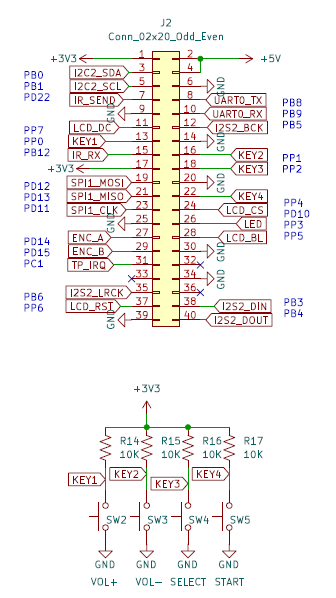Neza-D1开发板学习之按键和旋转编码器篇
-
-
Neza-D1开发板上只引出一个按键,是使用的LRADC检检测按键的,想使用更多按键,可以使用板子上通过PCF8574扩展出来的IO,我画的扩展板使用了四个按键,分别为PP0,PP1,PP2,PP4

-
设备树配置如下 内核需要勾选 Polled input device skeleton
gpio_keys { compatible = "gpio-keys"; pinctrl-names = "default"; /*pinctrl-0 = <&key_pins>;*/ #address-cells = <1>; #size-cells = <0>; autorepeat; button@0 { label = "Key volume up"; linux,code = <KEY_VOLUMEUP>; gpios = <&pcf8574 0 GPIO_ACTIVE_LOW>; /* PP0 */ }; button@1 { label = "Key volume down"; linux,code = <KEY_VOLUMEDOWN>; gpios = <&pcf8574 1 GPIO_ACTIVE_LOW>; /* PP1 */ }; button@2 { label = "Key back"; linux,code = <KEY_BACK>; gpios = <&pcf8574 2 GPIO_ACTIVE_LOW>; /* PP2 */ }; button@3 { label = "Key enter"; linux,code = <KEY_ENTER>; gpios = <&pcf8574 4 GPIO_ACTIVE_LOW>; /* PP4 */ }; }; -
编码器接在D1的PD14 PD15 设备树如下
注意需要内核勾选<*> Polled GPIO Decoder Input driverrotary { compatible = "rotary-encoder"; pinctrl-names = "default"; /*pinctrl-0 = <&rotary_pins>;*/ gpios = <&pio 3 14 GPIO_ACTIVE_LOW>, <&pio 3 15 GPIO_ACTIVE_LOW>; /* PD14, PD15 */ linux,axis = <0>; /* REL_X */ rotary-encoder,encoding = "gray"; rotary-encoder,relative-axis; };然后在内核勾选
-
系统启动会有如下log
[ 0.111735] input: sunxi-keyboard as /devices/virtual/input/input0 这是板载的那个LRADC 按键 [ 1.668976] rotary-encoder soc@3000000:rotary: gray 这是旋转编码器 [ 1.675145] input: soc@3000000:rotary as /devices/platform/soc@3000000/soc@3000000:rotary/input/input1 [ 3.178668] input: soc@3000000:gpio_keys as /devices/platform/soc@3000000/soc@3000000:gpio_keys/input/input5 这是扩展出来的那4个按键 -
查看系统里已注册的输入设备,用这个比较清楚,ls /dev/input也可以
# evtest No device specified, trying to scan all of /dev/input/event* Available devices: /dev/input/event0: sunxi-keyboard /dev/input/event1: soc@3000000:rotary /dev/input/event2: sunxi-ir /dev/input/event3: audiocodec sunxi Audio Jack /dev/input/event4: soc@3000000:gpio_keys /dev/input/event5: ns2009_ts -
可以使用evtest或hexdump来测试按键是否正常了
-
在代码使用就比较简单了
#include <errno.h> #include <global.h> #include <linux/fcntl.h> #include <linux/input.h> #include <signal.h> #include <stdio.h> //-std=c99 -std=gnu99 #include <stdlib.h> #include <string.h> #include <sys/types.h> #include <unistd.h> #define msleep(t) usleep((t)*1000) FILE *fp; int32_t fd_key; int32_t fd_encoder; struct input_event t; int main(int argc, char const *argv[]) { fd_key = open("/dev/input/event1", O_RDONLY | O_NONBLOCK); if (fd_key < 0) { fprintf(stderr, "error:can not open /dev/input/event1\n"); return -1; } fd_encoder = open("/dev/input/event4", O_RDONLY | O_NONBLOCK); if (fd_encoder < 0) { fprintf(stderr, "error:can not open /dev/input/event4\n"); return -1; } while (1) { // rotary encoder if (read(fd_encoder, &t, sizeof(t)) == sizeof(t)) { if (t.type == EV_REL) { LOG_D("ROTARY DIR: %d->%s\n", t.value, t.value == 1 ? "CC" : "CW"); rotary_encoder_handler(&u8g2, t.value); } } // key if (read(fd_key, &t, sizeof(t)) == sizeof(t)) { if (t.type == EV_KEY) { switch (t.code) { case KEY_OK: LOG_D("KEY_ENTER %s \n", t.value ? "Pressed" : "Released"); if (t.value == 0) rotary_encoder_button_handler(&u8g2); break; case KEY_SELECT: LOG_D("KEY_SELECT %s \n", t.value ? "Pressed" : "Released"); break; case KEY_VOLUMEUP: LOG_D("KEY_VOLUMEUP %s \n", t.value ? "Pressed" : "Released"); if (t.value == 0) { rotary_encoder_handler(&u8g2, -1); } break; case KEY_VOLUMEDOWN: LOG_D("KEY_VOLUMEDOWN %s \n", t.value ? "Pressed" : "Released"); if (t.value == 0) { rotary_encoder_handler(&u8g2, 1); } break; default: break; } } } usleep(1); } return 0; }
-
-
居然还有轮询的旋转编码器驱动,学到新姿势了。
Copyright © 2024 深圳全志在线有限公司 粤ICP备2021084185号 粤公网安备44030502007680号